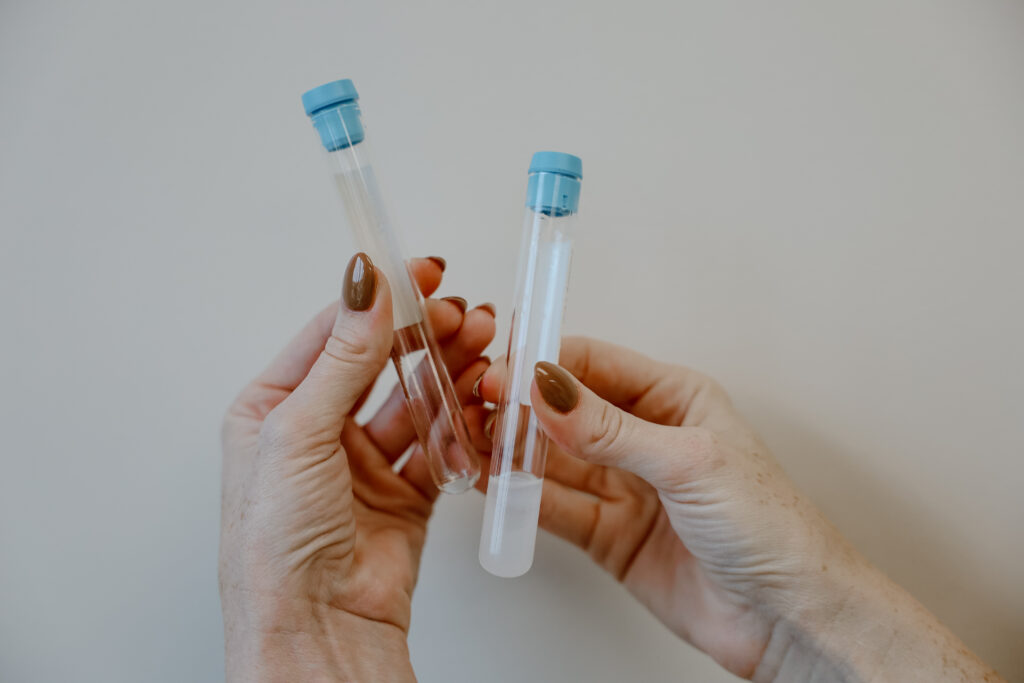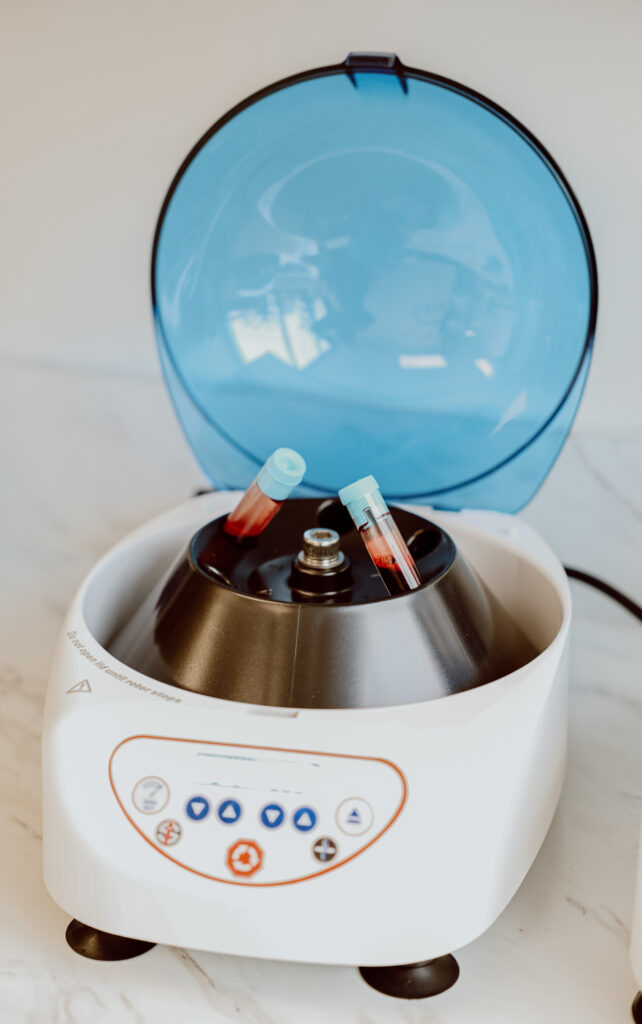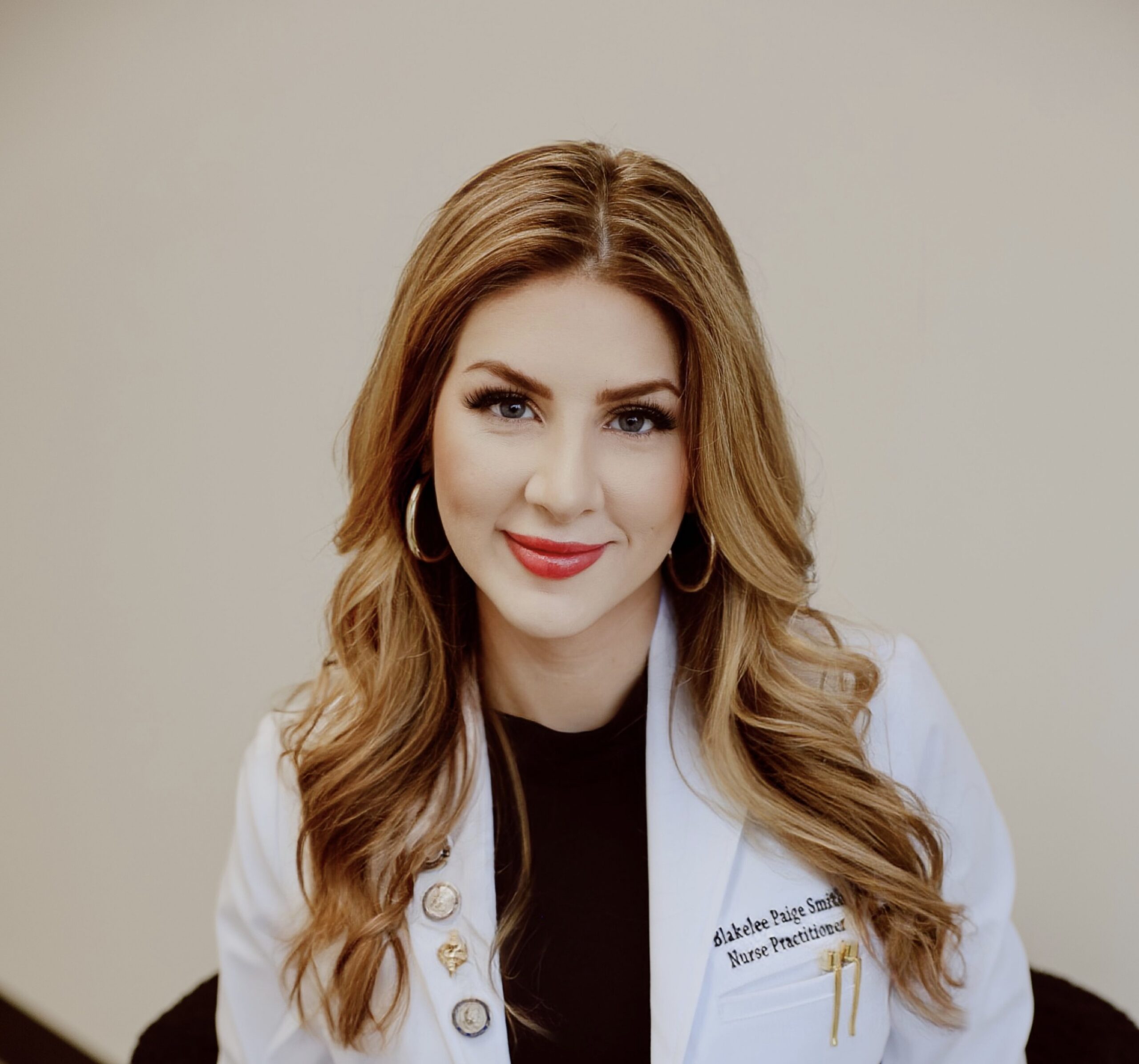Another Natural Option: PRF
June 14, 2024
Last week I discussed what PRP is, how it is used, and some indications of it both in and outside of clinic. If you haven’t already, be sure to go check it out, as I explained a little about why I love it as a treatment option and had to have it on my “menu” at Skin + Aesthetics. Today, however, I want to shift and focus on another “must-have”– PRF, which is also known as platelet-rich fibrin.
As with PRP, PRF is autologous, meaning it comes from you. There are several key differences that set PRP apart from PRF though and I think it is important to go over this so that it shows why I decided to have multiple “natural” options to choose from at S+A.
[As with the last blog on PRP, as a side note, I know that some providers have mentioned that they reference my blogs and some patients also like going into every detail while others like to keep it surface level. While I’ve aimed this blog post to go a bit deep into these topics, I’ve ended each question with “The Gist of It” in hopes to make it easier for those that wish to learn but also not dive into all the details. You’re welcome to choose whichever you’re looking for… or both!]
How do you obtain PRF?

Last time I started the blog with discussing how PRP is obtained. The process for PRF is very similar, but the difference in both PRP and PRF begins with how it is obtained, so I also will start there today. Just like with PRP, I start by drawing a sample of your blood in the clinic. Once again, the sample of blood is taken from a peripheral vein and placed in a specific PRF tube labeled with your name, then taken to the centrifuge. We take handling of bodily fluids very seriously, so all protocol in my clinic related to this follows best evidence-based practice, as well as OSHA and CDC regulations.
I covered specifics in how PRP is obtained in last week’s blog, so for this week I’m going to make this a bit more simple and say that PRF is going to differ in preparation in a few key ways: the tube it is drawn in and the centrifuge process. I’ll first start by covering the difference in the tube that I draw the blood into and why it is such a key difference.
1) The Tube!
In PRP, an anticoagulant exists in the tube that I draw your blood into; with PRF, however, this isn’t the case. The absence of anticoagulants in the preparation of PRF compared to in PRP is a key factor that influences each treatment’s distinct properties and applications. With PRP, the aim is to obtain a high concentration of platelets in a liquid plasma form for immediate use. Anticoagulants prevent clotting, allowing the platelets to remain suspended in the plasma and ready for injection. With PRF though, the goal is to create a natural fibrin matrix that acts as a scaffold for cell migration and tissue regeneration. This matrix is formed by allowing the blood to clot naturally during the centrifugation process, so this is why it is important that no anticoagulant is involved.
2) The Spin!
Next up, a key difference in PRP and PRF is how it is spun down. With PRP, the anticoagulant in the vial prevents the blood from clotting, which means that the platelets will remain a liquid during the centrifugation process. To ensure that the platelets are concentrated and isolated, a higher-speed centrifugation process is used, but remember, I said that with PRF we don’t have any anticoagulant present.
With PRF, the absence of that anticoagulant means I need to act a little faster, so I take the blood immediately to the centrifuge and get to work. The lack of anticoagulant allows the blood to form a clot during the centrifugation, which forms a fibrin matrix that I’ll break down further in a few moments. But because I want this matrix and clotting process to happen, I specifically will utilize a lower speed spin to help separate the blood components, but without disrupting the natural clotting process.
The Gist of It: We draw your blood in clinic in the exact same manner as we do for PRP, but PRF has two main differences– a different tube that allows it to clot and a slower spin in the centrifuge to allow that clot to form naturally.
What are the components?

I covered last time that the primary components of PRP include platelets, growth factors, and other bioactive proteins. For PRF, the primary components include-
1. Platelets – Last week, I took a deep dive into what platelets are and why I love them, so I’ll spare reiterating all of that this week and you can just go check it out here if you haven’t already. I mention that with PRP, platelets are concentrated 2-10 times what naturally occurs. With PRF, that amount is lower and is closer to 2-3 times.
2. Growth Factors – As we discussed last week, platelets are rich in growth factors that are essential for tissue repair and regeneration. I’m going to keep this one pretty to the point. These growth factors include:
• Platelet-Derived Growth Factor (PDGF): Promote cell proliferation and angiogenesis.
• Transforming Growth Factor-Beta (TGF-β): Regulate cell differentiation and immune function.
• Vascular Endothelial Growth Factor (VEGF): Stimulate the formation of new blood vessels.
• Epidermal Growth Factor (EGF): Enhance cell growth and differentiation.
• Insulin-Like Growth Factor (IGF): Support cellular growth and development.
3. Leukocytes (White Blood Cells) – You’ll notice this is a new component that wasn’t listed in last week’s discussion. This is because PRP typically has a much, much lower concentration of white blood cells included in it and this is on purpose due to how it is spun down. Leukocytes play a role in immune response and inflammation control. They help in fighting infections and managing inflammation at the site of injury. Leukocytes in PRF contribute to its antibacterial properties and help modulate the healing process, but are left out of PRP to focus more on regeneration.
4. Fibrin Matrix – I told you I would break this one down earlier and the time has arrived! The fibrin matrix forms the structural scaffold of PRF and it is the key difference between the two. It is a three-dimensional network that supports cell migration (aka provides a structure for cells to attach and proliferate), creates a more sustained release of growth factors (think a more gradual release of growth factors over a longer period of time versus how PRP works), and promotes angiogenesis (the formation of new blood vessels for regeneration).
5. Cytokines and Other Bioactive Molecules – These were covered with PRP, but include interleukins that modulate immune responses and inflammation, chemokines that attract cells to the site to promote tissue repair, and matrix metalloproteinases that remodel the extracellular matrix and aid in tissue repair.
6. Mesenchymal Stem Cells (MSCs) [Occasionally Found] – In some preparations, PRF can also contain small numbers of mesenchymal stem cells, which have the potential to differentiate into various cell types and contribute to tissue regeneration.
PRF’s composition—rich in platelets, leukocytes, and embedded within a fibrin matrix—makes it a powerful tool for enhancing tissue repair and regeneration. Its components collectively contribute to a conducive environment for healing, reducing inflammation, and promoting tissue regeneration. On top of that, the gradual release of growth factors from the fibrin matrix ensures prolonged stimulation of the healing process.
The Gist of It: PRF has a lower concentration of platelets versus PRP, but a higher concentration of white blood cells. It also has a fibrin matrix, which translates into a more prolonged release of growth factors and prolonged healing process.
What does PRF treat?
Like PRP, PRF can also be used in both medical and aesthetic conditions. PRF is offered in dental and oral surgery (not offered at S+A), in orthopedic conditions such as in fracture repair and to support healing of torn ligments and tendons (not offered at S+A), and in skin rejuvenation to improve skin texture, elasticity, and overall appearance (definitely offered at S+A).
Where I really want to focus here is that you may notice hair loss wasn’t listed for a PRF treatment, whereas it was for PRP. The truth of the matter is that several well-controlled clinical studies have shown that PRP is an effective treatment in promoting hair regrowth in people with androgenetic alopecia, which is also known as male or female pattern hair loss, as well as in other types of alopecia or hair loss. These studies show PRP is effective in producing an increase in hair density and thickness, as well as a decrease in hair loss. While PRF has also been studied for its potential use in the treatment of hair loss, the honest truth is that there is much less evidence available on its efficacy. It is worth noting that one small study found that PRF injections may be effective in promoting hair growth in people with androgenetic alopecia, but the results were not statistically significant and more research is needed to confirm these findings. Because of that, I personally prefer to offer the treatment options that have the highest level of efficacy, so I use PRP in my hair loss patients at S+A.
Although this isn’t straightforward all the time, the breakdown of what I typically treat-
- PRP: Facial rejuvenation, hair loss, acne scars, etc.
- PRF: Wrinkle reduction, volume restoration, wound healing, etc.
The Gist of It: PRP and PRF both treat some of the same conditions, just in a slightly different way. The key difference at S+A is that we choose to use PRP for hair loss patients who are a candidate, as evidence as of today (this can always change) is stronger for efficacy of PRP in hair regrowth and we always want to do what is best for our patients. The choice between PRF and PRP depends on the specific clinical needs and desired outcomes, with PRF being more suitable for applications requiring a scaffold and sustained growth factor release, and PRP being preferred for conditions needing immediate and concentrated growth factor effects.
How long does it last?
You should know by now that the answer if never straightforward on how long any aesthetic treatment will last, as the duration of aesthetic results can vary depending on several factors, including the specific procedure, the patient’s skin type and condition, and lifestyle factors. Generally speaking, here’s what you can expect regarding the longevity of aesthetic results from PRF treatments:
1. Skin Rejuvenation:
• Initial Results: Patients often notice improvements in skin texture, tone, and overall appearance within a few weeks of treatment. This is due to the initial boost in collagen production and tissue regeneration.
• Sustained Results: The benefits of PRF for skin rejuvenation, such as increased collagen and elastin production, can continue to improve over the next several months. The effects typically last between 6 to 12 months. Maintenance treatments can extend these results.
2. Under-Eye Treatments:
• Initial Results: Reduction in dark circles, puffiness, and fine lines can be observed within a few weeks. The skin appears more youthful and refreshed.
• Sustained Results: The aesthetic improvements can last around 6 to 12 months, depending on individual factors and the number of treatments received. Regular touch-up treatments can help maintain the results.
As with PRP, many factors play into these results, such as age, genetics, and lifestyle factors. Younger patients with healthier skin may experience longer-lasting results compared to older patients with more damaged or aged skin and excessive sun exposure can accelerate skin aging and diminish the longevity of PRF results. In addition, the consistent use of quality skincare products, including sunscreen, can help maintain the benefits of PRF treatments as well as a healthy diet and adequate hydration.
The Gist of It: The answer isn’t simple, but depending on the reasoning behind the treatment, results can be seen in as little as weeks after the treatment and can last for about a year. However, many factors depend on this and results may vary.
How is PRF different from PRP?
Okay, here’s the big question you’ve been waiting for! Let’s break down all we’ve learned into a clear and concise battle between the two.
• PRF: Without anticoagulants, the natural clotting process forms a fibrin matrix that gradually releases growth factors, promoting prolonged healing and regeneration, and the presence of leukocytes also adds to the regenerative potential. As far as consistency goes, PRF is more gel-like, which does provide a bit more “instant gratification” effect when injecting it for volumization of the face in anti-aging or rejuvenation. However, I think it is important to note that these instant results are a combination of swelling/inflammation from the injections and the volume or consistency of the PRF itself. Its sustained release of growth factors supports long-term healing and stimulation of results, which means the results will actually come in weeks and months to follow. The though process based on research and what we know so far is that the results are slower, but potentially more effective when looking at revolumization of the face. The natural clotting process and absence of additives also reduce the risk of adverse reactions and the inclusion of leukocytes and the fibrin matrix enhances its regenerative properties.
• PRP: The use of anticoagulants ensures that the platelets remain in a liquid state, allowing for the rapid release of growth factors upon application or injection. This is beneficial for treatments requiring immediate therapeutic effects. In contrast from PRF, the consistency of PRP is very liquid and almost water-like., which does make for am easier injection, but a less gratifying immediate result because it has no real sturdiness.
In summary, the absence of anticoagulants in PRF preparation is essential for forming a natural fibrin matrix that supports sustained release of growth factors and tissue regeneration. PRP, on the other hand, requires anticoagulants to maintain platelets in a liquid state for immediate application. These differences in preparation and properties dictate their respective clinical applications and therapeutic benefits.
Wrapping it up
So, while PRP and PRF are similar in some ways, there are also key differences and I felt the differences and the results those differences create were stark enough that I needed to be able to offer both PRP and PRF in the clinic. In fact, especially when doing tear trough augmentation, there are times I will end up using a combination of PRP, PRF, and ezGEL treatments to achieve full resolution.
Next up on the list I’m planing to tackle discussing ezGEL, so be sure to check out that blog after this one! If you’d like to schedule a consultation to talk more about natural anti-aging, simply click here or give us a call. As always, if you have questions or concerns, don’t you dare hesitate to reach out! I’m always here to help.
Until next time,
Blakelee Paige Smith, MSN, APRN, AGPCNP-BC, NP-C
Dual Board-Certified Nurse Practitioner + Owner
Skin + Aesthetics
[As a reminder, all blogs are sole property of Blakelee Paige Smith, NP and Skin & Aesthetics TN LLC. Blogs are not to be copied or distributed, neither partially or in entirety. All rights reserved.]

Dual board-certified nurse practitioner, dermatology fanatic, aesthetic injector, passionate educator, clinical speaker, and proud owner of Skin + Aesthetics in Cookeville, Tennessee!